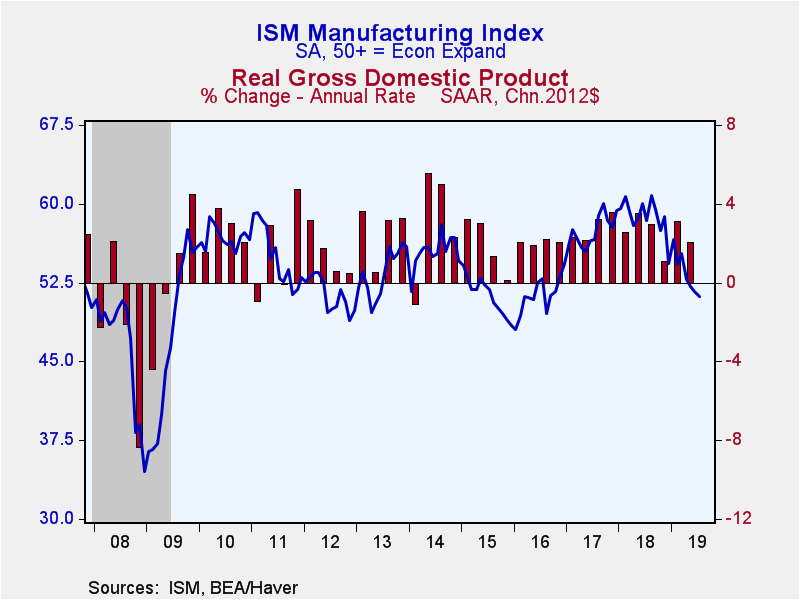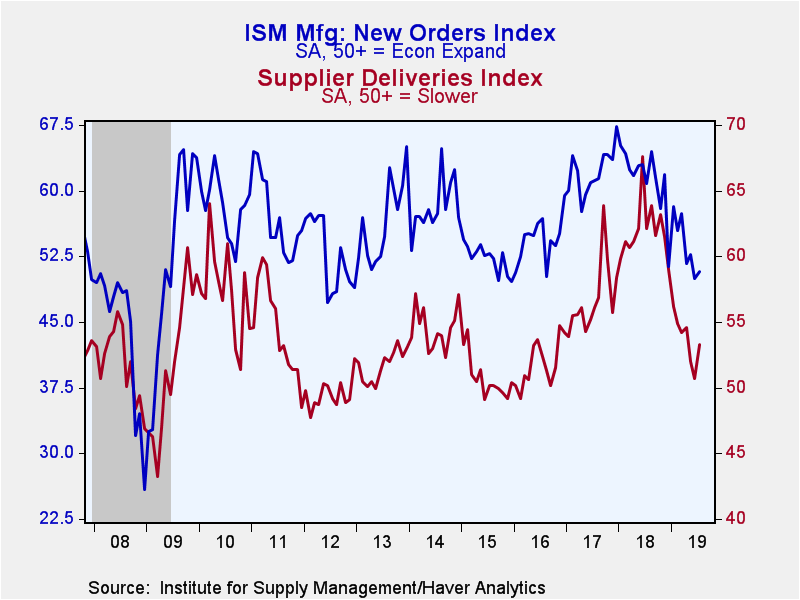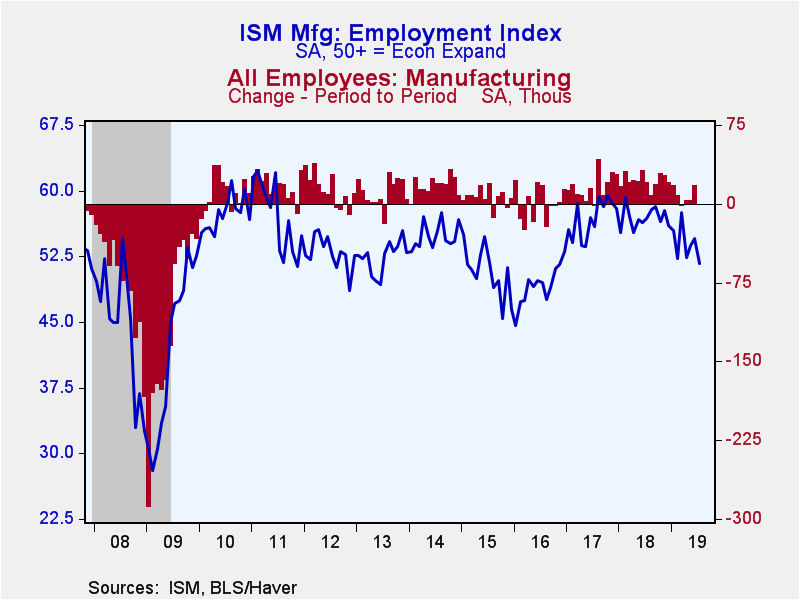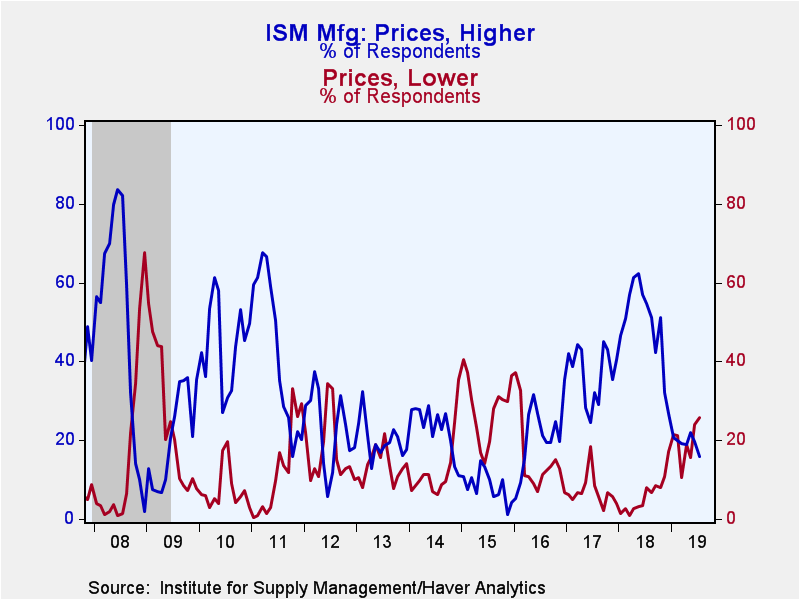 Global| Aug 01 2019
Global| Aug 01 2019ISM Manufacturing Composite and Prices Indexes Weaken
by:Tom Moeller
|in:Economy in Brief
Summary
The ISM manufacturing index slipped to 51.2 during July from 51.7 in June. It was the lowest level since August 2016 and was below the expansion peak of 60.8 last August. The Action Economics Forecast Survey anticipated a reading of [...]
The ISM manufacturing index slipped to 51.2 during July from 51.7 in June. It was the lowest level since August 2016 and was below the expansion peak of 60.8 last August. The Action Economics Forecast Survey anticipated a reading of 52.0. Since 2008, there has been a 74% correlation between the index level and quarterly growth in real GDP.
Performance amongst the ISM index components remained mixed last month. The production series fell to 50.8, its lowest point since January 2016. Working higher, the new orders reading improved slightly to 50.8 while the inventories measure rose to 49.5, but still indicated a rundown of inventory levels. The supplier delivery index rose to 53.3, the highest level in three months and indicated slightly slower delivery speeds.
Also moving lower was the employment index to 51.7, its lowest point since November 2016. A lessened 19% (NSA) of respondents reported higher payrolls while an increased 15% reported a decline. Since 2008, there has been an 84% correlation between the employment index and the m/m change in factory sector payrolls.
The prices paid series, which is not part of the composite series, continued to fall. The decline to 45.1 indicated price deflation for the fourth month this year and was below the high of 79.5 in May of last year. A lessened 16% of respondents reported increased prices while an increased 26% reported lower prices, up from nearly none in March of last year.
Amongst other series in the ISM survey, the export index fell below break-even to 48.1, and remained significantly lower than the February 2018 high of 62.8. The order backlog measure dropped to 43.1, indicating a fall in backlogs to the quickest rate since January 2016.
The ISM figures are diffusion indexes where a reading above 50 indicates expansion. The figures from the Institute for Supply Management can be found in Haver's USECON database; further detail is found in the SURVEYS database. Commodity prices can be found in USECON as well as the CMDTY database. The expectations number is available in Haver's AS1REPNA database.
| ISM Mfg (SA) | Jul | Jun | May | Jul'18 | 2018 | 2017 | 2016 |
|---|---|---|---|---|---|---|---|
| Headline Index | 51.2 | 51.7 | 52.1 | 58.4 | 58.8 | 57.4 | 51.3 |
| New Orders | 50.8 | 50.0 | 52.7 | 60.8 | 61.4 | 62.2 | 54.5 |
| Production | 50.8 | 54.1 | 51.3 | 59.1 | 60.7 | 60.9 | 53.8 |
| Employment | 51.7 | 54.5 | 53.7 | 56.8 | 56.9 | 56.8 | 49.1 |
| Supplier Deliveries | 53.3 | 50.7 | 52.0 | 62.1 | 62.0 | 56.8 | 51.8 |
| Inventories | 49.5 | 49.1 | 50.9 | 53.3 | 52.9 | 50.4 | 47.5 |
| Prices Paid Index (NSA) | 45.1 | 47.9 | 53.2 | 73.2 | 71.7 | 65.0 | 53.1 |
Tom Moeller
AuthorMore in Author Profile »Prior to joining Haver Analytics in 2000, Mr. Moeller worked as the Economist at Chancellor Capital Management from 1985 to 1999. There, he developed comprehensive economic forecasts and interpreted economic data for equity and fixed income portfolio managers. Also at Chancellor, Mr. Moeller worked as an equity analyst and was responsible for researching and rating companies in the economically sensitive automobile and housing industries for investment in Chancellor’s equity portfolio. Prior to joining Chancellor, Mr. Moeller was an Economist at Citibank from 1979 to 1984. He also analyzed pricing behavior in the metals industry for the Council on Wage and Price Stability in Washington, D.C. In 1999, Mr. Moeller received the award for most accurate forecast from the Forecasters' Club of New York. From 1990 to 1992 he was President of the New York Association for Business Economists. Mr. Moeller earned an M.B.A. in Finance from Fordham University, where he graduated in 1987. He holds a Bachelor of Arts in Economics from George Washington University.










